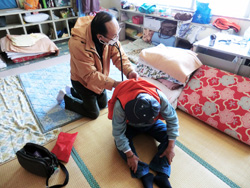The Association for Aid and Relief (AAR) is providing mobile medical treatment on the Oshika Peninsula in Miyagi Prefecture, one of the hardest-hit areas. Currently, the northern half of the peninsula is being covered by a medical team from Tokai University and the Japanese Red Cross Society, while the southern half is taken care of by a Self-Defense Force medical team. However, those teams are focusing their efforts primarily on evacuation centers and other such sites, so those who are in-home refugees, particularly those who are elderly or have physical limitations, are not receiving assistance or treatment. AAR has been reaching out to these people through a medical team headed by a local doctor, visiting homes and treating about 640 people while also surveying the damage and needs in the area.
The clean-up and rebuilding of the earthquake-struck area is a long-term process and volunteers continue to be needed. JEN is recruiting volunteers to assist with sludge removal over the upcoming Golden Week holiday (April 29 to May 8), while NICCO is recruiting corporate volunteers to commit to one month helping in Rikuzentakata and Kesennuma on projects related to food service, construction, disease control, and debris removal.
The Association of Medical Doctors of Asia (AMDA) is shifting to the reconstruction phase of its work. It is providing backup to hospitals in Otsuchi and Shizugawa as they try to get up and running again. At the same time, they continue to focus on the mental health of the evacuees who continue to endure life in the evacuation centers. At an evacuation center at Shizugawa Elementary School in Miyagi Prefecture, for example, the AMDA team served hot chocolate and coffee—a rare treat for evacuees. They also tried to give children a respite by baking cookies with some of them using a temporary oven.


